8 Chapter Nine – The 18th Century in Continental Europe
Chapter 9 – The 18th Century in Continental Europe
ITALY
Drama
For almost all of the 18th Century, Italian theatre was dominated by opera and performances focusing on music and dance. Straight plays and dramas did not get a lot of attention, with playwrights tending to write librettos for operas rather than investing in writing self-standing plays. Tragedies suffered the most, as we will have to wait until the very end of the century to see them flourish again under the hand of Vittorio Alfieri (1749-1803). The only tragedy of the early 1700s worth mentioning is Francesco Scipione di Maffei’s Merope, which recounts a classical story.
Between 1700 and 1750, the popularity of the Intermezzi grew significantly, leading them to become their own standalone genre: the opera buffa, or comedic opera (as opposed to the more traditional opera seria). Opera Buffa developed primarily in the south of Italy and then spread to up north to Milan and Venice.
These theatrical pieces could be one or two-act plays, featuring everyday characters (commoners) dealing with extravagant and comedic situations. Most of the operas were sung, but unlike opera seria, dialogue also had a significant role. The use of dialect instead of “Italian” was frequent, to appeal to the less learned audience.
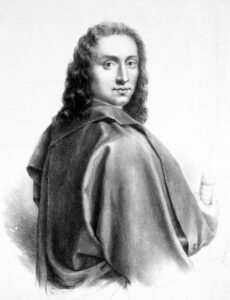
Giovanni Battista Pergolesi (1710–1736), a Neapolitan, became a very popular writer of this genre, despite his very short life. His most famous opera is La Serva Padrona (The Maid Turned Mistress), which is one of the few opera buffas still performed today. It is a short, forty-minute-long piece, divided into parts. The plot sees Serpina, the servant in the house of Uberto, becoming more and more arrogant and domineering with his master to the point that Uberto asks his friend Vespone to find him a wife, so that he could get rid of Serpina. Yet, Serpina convinces Vespone to trick Uberto into marrying her. The happy ending sees Serpina and Uberto happily married, as Uberto had realized he had loved her all along.
Aside from Pergolesi, another famous opera buffa author is Alessandro Scarlatti (1660-1725), who is also from Naples. Differently from Pergolesi, Scarlatti didn’t just focus on opera buffa, and his name is associated with most genres of the time, including opera seria, sonatas, cantatas, concerto grosso, and mass.
Comedies had a better following than tragedies, although the popularity of Commedia dell’Arte generated a myriad of plays that did not necessarily excel in quality. Plot lines started to be repetitive, characters became predictable (and therefore, less comedic) while greater attention was devoted to spectacle and adding music whenever possible. Happy endings weren’t always truly earned, and plays started to really delve into sentimentalism.
Yet, two playwrights must be acknowledged: Carlo Goldoni (1707-1793) and Carlo Gozzi (1720-1806), who both lived and worked mostly in Venice.
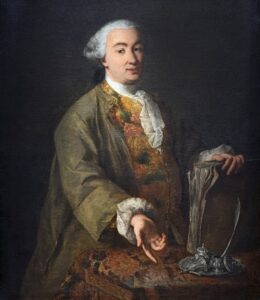
CC BY-SA 4.0
Carlo Goldoni wrote almost compulsively, penning over 150 comedies, a few tragedies, and over 80 musical dramas. The child of a middle-class family, he was originally from Venice but traveled extensively with Commedia dell’Arte troupes both nationally and internationally. He wrote in Italian, in Venetian, and because he was very much appreciated in France, he also wrote in French. He held a law degree and, at times, practiced as a lawyer in Venice. Interestingly, his first play to be produced was a tragedy, titled Amalasunta, which was staged in Milan in 1733.
He profoundly admired Molière and continued working on comedies, trying to combine the French playwright’s style with the strongest elements of Commedia dell’Arte.
His “comedic reform” intended to give comedy a higher status among genres by widening its intended audience and introducing a more relatable set of circumstances and characters. He advocated for writing a full script, rather than just a plot line, as previously customary in Commedia dell’Arte, with fully developed and scripted characters. This would mark the end of improvisation. While not completely abandoning some of the conventions of Commedia dell’Arte, he significantly reduced the use of masks. Most of his plays don’t make any use of the masks, while others only leave them on servants. Goldoni’s characters are less stereotypical than those we find in Commedia dell’Arte, and they speak truer to their environment, their social status, and their specific given circumstances. Plays provided an insight into relatable situations and institutionalized social hierarchies, leaving the audience guessing about the similarities with their everyday reality.
Goldoni considered writing for the theatre his main career, and therefore, he paid attention and tried to fulfill the audience’s expectations as much as possible. This caused some stir among scholars, who considered him to be too “commercial”. This resulted in a literary feud between him and two other writers, Carlo Gozzi and Pietro Chiari.
Considering the number of great comedies written by Goldoni, it is hard to select those that could be considered his best. For this chapter, the following should be mentioned: Servant of Two Masters, originally written in 1746 and then revised in its final form in 1789, The Two Venetian Twins (1747), The Mistress of the Inn (1751) and The Boors (1760).
Servants of Two Masters, also known as Arlequin Servant of Two Masters, was originally written for the famous actor Antonio Sacchi, who excelled in the role of Arlequin. The protagonist of the play is the servant, Truffaldino, who decides to serve two different masters to earn more money (and food). This will lead to confusion, mistakes, and ultimately chaos.
The Two Venetian Twins is based on Roman playwright Plautus’s Menaechmi and sees two twins who had been separated at birth ending up in Verona at the same time, one there to marry his fiancée and the other to meet his runaway girlfriend. Mistaken identities and slapstick comedy make this piece of theatre still popular to this day.
The Mistress of the Inn is centered around Mirandolina, a very clever and beautiful young woman who runs an Inn in Florence. She is set to marry her devoted servant and waiter at the inn, Fabrizio, but she hopes to marry up as three noble suitors constantly show up at her inn. In the end, she will relent and marry poor Fabrizio, although she admits not to love him and to marry him only because he won’t be an obstacle to her freedom.
The Boors follows the adventures of four very conservative Venetian merchants, who “fight” the frivolous new trends that are coming to town. This piece is relevant for its social satire and direct and honest depiction of the patriarchal Venetian middle class of the time. The four merchants, Lunardo, Maurizio, Simon, and Canciano, all try to suffocate their wives’ desires for some freedom and a modern lifestyle. This comedy is entirely written in Venetian dialect.
Contemporary Italian productions of Goldoni’s play respect their original language, so if they are written in Venetian dialect, that’s how they are performed. Yet, the use of subtitles is often introduced, in particular for productions outside of Venice.
In 1753, Goldoni left Italy to become the main playwright of the Comédie Italienne in Paris, where he eventually died in 1793. His departure was partially due to financial difficulties and to the feud with Petro Chiari, which culminated in the two playwrights “fighting” through plays. Chiari wrote several parodies of Goldoni’s plays to criticize Goldoni’s new approach to the comedic genre and his ultimate disrespect for its original form.
Pietro Chiari (1712-1785) lived his entire life in Venice, although he was born (and would later die) in Brescia. He was a Jesuit, but he left the order in 1747 to become the court poet of the Duke Francesco III d’Este. He published articles, scholarly essays, poems, and satirical pieces, along with several comedies. His aesthetic and social views were generally very conservative, and it all surfaced in his writings. His comedies were a direct response, or a parody even, to Goldoni’s new comedic style, which Chiari overtly disliked and criticized.
Eventually, time will resolve the quan drum: while Goldoni’s works are still widely produced today all over the world, Chiari’s plays receive little to no attention.
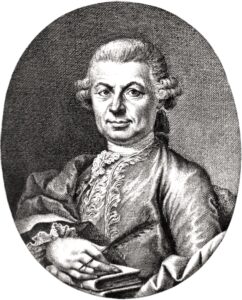
Carlo Gozzi (1720-1806) was another Venetian playwright and scholar who didn’t quite agree with Goldoni’s new comedic style and re-definition of the genre. His main mission was to preserve and perpetuate the principles of Commedia dell’Arte, so when Goldoni claimed the need to modernize the style, he fiercely opposed it by writing plays in the “original” style of Commedia dell’Arte. His plots revolved around fairy tales and mythical elements. His first play, L’ L’Amore delle Tre Melarance (The Love for the Three Oranges), dated 1761, is his manifesto against both Goldoni’s and Chiari’s concept of comedy. The play was very successful and prompted him to keep writing, resulting in a series of theatrical fables, some of which are still very popular, including Turandot and La Donna Serpente (The Serpent Woman). His success transcended the confines of Italy, and many of his works were well-received and produced in Austria and Germany. Moreover, Gozzi’s Turandot inspired Puccini’s opera by the same title.
Yet again, today, Goldoni is still the most popular Italian playwright of the time when it comes to plays in production.
Architectural spaces and theatrical design
The end of the 17th Century and the whole 18th Century saw Italy building bigger and more “technologically” advanced theatres. The proscenium arch, the chariot-and-pole system, the painted scenery, and the perspective became staples, allowing productions to be more and more spectacular.
As a general trend, some of the neoclassic features of the Renaissance – such as the use of symmetry in the design, the homage to classic elements and the use of rectangular shapes – tended to be abandoned in favor of the new predicaments of the up-and-coming Baroque style, which aimed at achieving more extravagant designs and theatrical spaces through the use of lavish decoration, curvilinear shapes and asymmetrical spaces. The goal was to provide an idea of grandeur, splendor, and monumentality. In this regard, columns, friezes, arches, and pediments were still very much employed, yet they became more ornate and detailed.
Scenic design, along with theatre design, remained for the most part a “family business.” The Bibiena family, in particular, specialized in theatrical design and built several theatres in Italy and all over Europe. Ferdinando Bibiena (1657-1743) is credited for introducing the “angle perspective” (scena ad angolo), which would significantly change the perception of the scenery by providing two vanishing points (instead of just one) on the upstage panels of the setting. In this manner, the scenery could be arranged on the stage in a way that didn’t exclusively rely on central sightlines.
Ferdinando Bibiena also modified the scale of the sets and more clearly divided the stage into a lower part, which would be where the actors would perform, and an upper part that would be used as a background for the scene, providing a much greater illusion of space.
In the downstage area, there would be the usual sets of wings operated by the chariot-and-pole system.
Another important architect of the time was Filippo Juvarra (1678-1737). He worked in Naples and in Turin, which were to become the artistic “hubs” of the new style in Italy for the entire century. Juvarra’s style fully embraces the Baroque aesthetic, with a systematic use of curvilinear lines, which would create complex concentric spaces.
When it comes to scenery, Juvarra added draperies and exotic elements to his designs to enhance spectacle.
Other theatre designers included the Mauro family, mostly active in Germany, and the Galliari family, who worked mostly in Turin and Milan.
In the second part of the 18th Century, there is a slight move back towards a leaner and less ornate design style. This came as one of the consequences of the rediscovery of several Roman archaeological sites, such as Pompei and Ercolano. As the sites were excavated, bringing the ruins back to fruition, many artists were able to have access to them and draw them. The circulation of these drawings and engravings made Pompei and Ercolano incredibly popular, steering designers to emulate some of their features. One of the most famous artists portraying the ruins is Giovanni Battista Piranesi (1720-1778), who is believed to be the author of more the one thousand engravings. He is credited for introducing the concept of “mood” in his drawings, a concept that will then also be applied to scenic design. “Mood” meant that designers started to consider how the light could influence the perception of the space. Atmospheric textures, qualities, and shadows were applied to scenic design to better render a time of day or a location.
TAKEAWAYS
Pergolesi’s Opera Buffa became a very popular genre in Italy, combining original music with more compelling storytelling.
One of the most popular Italian playwrights of the time was Carlo Goldoni, who wrote mostly comedies. He moved forward from Commedia dell’Arte and theorized a new form of comedy.
Another famous playwright, mostly writing comedies, is Carlo Gozzi, who was more interested in the traditional aspect of Commedia.
Carlo Gozzi and Carlo Goldoni had opposite ideas about the genre of comedy and its connection with Commedia dell’Arte.
When it comes to architecture, the greatest innovation of the century was the introduction of the angled perspective (“scena ad angolo”) by Bibiena. Another important name in scenic design and theatre architecture is Juvarra.
Many designers and architects of the time were mostly influenced by the rediscovery of the Roman archaeological sites as depicted, for example, by Piranesi.
FRANCE
The 18th Century will bring many changes in France, changes that will lead to a completely new social, political, and artistic scenario in the following century.
In the first few decades of the 1700s, France was at war against Spain, England, and Austria. In the meantime, they also lost several of their overseas colonies. All this significantly impacted the state finances and resulted in heavy taxation on the rising middle class.
Paris remained the center of all the cultural life of the country, and of Europe in general, despite all the turmoil.
There were only two “official” resident companies in Paris: the Comédie Française and the Opéra. The first one was only producing straight plays (both comedies and tragedies), while the second one focused on operas and plays with music. Both these companies received an allowance from the state and from the city of Paris, yet, because of the number of plays they put on, the increasing number of resident actors and artists in them, and the not-so-great audience attendance, they always struggled financially.
In terms of acting and actors’ training, France was ahead of the game when, in 1786, the Royal Dramatic School was funded, within the premises and under the supervision of the Comédie Française. The school provided rigorous training and paired the students with company members, who functioned as mentors. Students would shadow (or understudy) said company members for at least a couple of years, and they would perform at least three times in front of an audience.
In 1716, an Italian Commedia dell’Arte troupe – the Comédie Italienne – led by Luigi Riccoboni was granted the use of the Hôtel de Bourgogne, thus becoming the third legal company to be able to work in Paris.
Unofficially, though, many other small theatres and theatre companies operated in and around town, producing a lot of new works that were more akin to the taste of the masses. These theater companies originally performed during fairs, specifically the St. Germain fair (from the beginning of February to Easter) and the St. Laurent fair (from the end of June through October). Later, these theatre companies found their own home in small venues and buildings around Boulevard du Temple, thus acquiring the name of “boulevard theatres”. They were operated privately by managers, who were financially responsible for them. It could be said that boulevard theatres were more “commercial”, as their fortunes – or misfortunes – entirely depended on the success of their production and the audience attendance.
Boulevard theatres mostly produced opéra comiques (comic opera), which evolved greatly during the century as they embraced a more sentimental trend in plots and characters, veering away from farcical situation comedies and from Commedia dell’Arte stock characters, added popular tunes first and original music later, and finally incorporated dance sequences. The addition of original music to the French opera comique is attributed to the popularity of Giovanni Battista Pergolesi’s The Servant Mistress, which opened at the Comédie Italienne in 1752. Pergolesi’s work triggered the so-called Querelle des Bouffons (The Fight of the Comic Actors), a feud between the supporters of the Italian style opera and the French one. The more “progressive” scholars, philosophers, and thinkers – mostly those involved in writing the Encyclopédie – favored the more spontaneous and original Italian opera, while the more conservative scholars would advocate for French composers, such as Lully. This dispute went on for a couple of years, was basically never “resolved”, and produced about forty pamphlets.
Drama
French playwrights of this period stayed true to the artistic trend that had been originated by Racine in the previous decades. Plots still preferred mythological and classical themes, and tended to be complex and rather long. Tragedies also needed to have elevated language.
The French playwrights that contributed to French theatre and who are worth mentioning in the 18th Century are: Joseph de LaGrange-Chancel (1677-1758), Prosper Jolyot Crébillon (1674-1762), Voltaire (1694-1778), and Denis Diderot (1713-1784) for drama and tragedies; Florent-Carton Dancourt (1661-1725), Pierre Carlet de Chamblin de Marivaux (1688-1763), Alain René Le Sage (1668-1747), and Pierre Claude Nivelle de LaChaussée (1692-1754) for comedies. At the end of the century, the biggest name in French theatre was Pierre Augustin Caron, known as Beaumarchais (1732-1799).
Both LaGrange-Chancel and Crébillon really focused on forwarding the style and themes previously developed by Racine. Their tragedies were rooted in Classic myths, to which they provided their own spin. LaGrange-Chancel focused on characters and on their development and provided his plays with several reversals and subplots, and at times he even settled for a happy ending: all elements that veered away from the Neoclassic principles. Some of his plays, like Ino and Mélicerte, for example, can almost be considered melodramas. Contrarily, Crébillon stayed true to the gruesome nature of the tragic genre. He even added his ideas to myths and classic plots in order to increase the horrifying experience for the audience. An example of this lies in his Electra, a play based on the Classic Greek Theban cycle as portrayed in Aeschylus’ Oresteia. Crébillon gives Aegisthus two children, so that they could become a greater obstacle to his internal motivation.
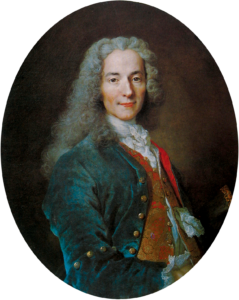
Nicolas de Largillière, 1724. Public domain, via Wikimedia Commons
François-Marie Arouet, known as Voltaire, is one of the most influential French scholars of the 18th Century, who also happened to write some very good plays (out of a total of fifty-three). Most of his work, regardless of the platform, reflects his philosophical and social ideas, which revolved around freedom of thought and religion. He was the son of a lawyer, who wanted his son to follow in his footsteps, and while he did study law and practice it for some time, he was most interested in becoming a writer. Young Voltaire also had very strong ideas about social justice and freedom of thought, which meant that he often criticized the government….which meant he got in trouble a few times and was imprisoned twice. Later, he went to England as a self-exile in order to avoid a third stint in jail. He stayed in England for two years, where he was exposed to British theatre and to Shakespeare in particular, which would leave quite an impression on him and eventually led him to advocate for the abandonment of the Neoclassic principles.
Voltaire traveled a lot, mostly spending time in Holland, Prussia, and Germany, following the invitations of local authorities. He finally returned to Paris at the age of 83 in 1778 to see the opening of his latest play, Irene. Yet, the journey took a toll on him, and he died a few months later.
Voltaire pleaded for a reform in theatre – amongst other things – specifically in the tragedies, as he claimed the Neoclassical principles were obsolete. While not completely rebelling against them, Voltaire advocated for widening the net of possible subjects to be developed and types of characters. He also reintroduced (some) violence on stage. Finally, his dislike for the common practice of having part of the audience on stage ultimately led to a final separation of the two spaces: the stage, for the exclusive use of the actors, and the house for the audience.
His most famous plays are Zaire, an ill-starred love story stained by false accusation and jealousy, and Trancrède, where the source of inspiration is a popular French tale of the Middle Ages. Both plays deal with subject matters and are set in time/locations that are somewhat “exotic,” and these wouldn’t have been considered suitable options in the previous century’s theatrical aesthetic. Zaire is set in the Middle East and depicts the love between a Sultan and a slave, while Trancrède starts the trend of celebrating subjects of national heritage.

*oil on canvas
*81 x 65 cm
*signed: L. M. Van Loo / 1767
Louis-Michel van Loo, Public domain, via Wikimedia Commons.
The idea of moving away from classic subject matter was furthermore championed by Denis Diderot, who can be credited for introducing a new genre, the “drame” (or domestic tragedy), which basically would include plays that didn’t comply with the Neoclassic principles and definition of tragedy. Diderot claimed that it was important to provide an illusion of reality if the audience was expected to be moved by what they were seeing on stage; therefore, it was necessary to tell stories that were closer to the audience and featured characters they could potentially identify with. Everyday life situations could easily escalate through extraordinary circumstances, and ordinary characters could rise to the occasion as they would in real life. Diderot wasn’t opposed to introducing elements of comedic relief as well, as such is life.
This ideology, which was common among several scholars, dramatists, and philosophers of the time, partially resulted from witnessing a shift in the demographic of French audiences, thanks to the rise of the middle class, the bourgeoisie.
Diderot’s ideas can be found in the dialogue of a couple of his plays: The Father of a Family and The Natural Son, and most importantly in his essay Discourse on Dramatic Poetry.
In many ways, Diderot theorized what would become realism at the end of the 19th Century.
In another significant essay, the Paradox of Acting (published after his death), Diderot claimed that actors needed to use technique to coax emotions rather than trying to emote those feelings themselves, and they went along. This would be the first time a similar concept would be brought forward regarding the technique of acting. In the following centuries, there will be much debate about this very concept that Diderot introduced.
Diderot’s plays aren’t very popular today, and he is mostly remembered for his work on the French Encyclopédie, a monumental endeavor that kept him writing and editing for over twenty years.
THE ENCYCLOPEDIE
Denis Diderot started working on the Encyclopédie in 1751, completing it in 1772.
The work was intended to be a comprehensive reference to learn about the sciences and the arts. It was to gather all the available knowledge and present it through the lenses of a critical and rational investigation so that it could be used for social advancement.
It became the vehicle of all the ideals and principles of the Enlightenment, a philosophical movement that advocated for a more secular and rational approach to politics, society, and the sciences. Because of its approach, the French government and the church condemned it and outlawed it in 1759. Yet, Diderot ignored the ban and kept working on it in secret with the other contributors, having the volumes published outside the borders of France, so that it wouldn’t fall under the French jurisdiction.
The Encyclopédie comprised 28 volumes with contributions from 150 scholars, the most famous being Diderot himself, who wrote about 7000 articles in it, Voltaire, Rousseau, and Montesquieu. The most prolific contributor was Louis de Jancourt, who penned 17266 articles!
It became one of the first – and the most influential – works of the like, paving the way to all modern encyclopedias… Including Wikipedia!
When it comes to comedies, during the first part of the 18th Century, France was still very much following the lead and the preachings of Molière.
Comedies relied on plots involving the new up-and-coming middle class who aspired to live a social lifestyle that belonged to the upper classes.
Writers such as Dancourt and Regnard were very prolific and active in the theatrical scene in Paris, the first one primarily working at the Comédie-Française and the second one being a member of the Commedia troupe. One of Dancourt’s most successful plays is The Fashionable Gentleman, whose protagonist is a gigolo who woos three wealthy women, hoping to socially (and economically) advance himself.
Regnard’s work is more in the fashion of Commedia dell’Arte, with complex and fast-paced, farcical plots. This would also be the style of choice of Marivaux, who wrote about thirty-five plays and worked mostly with the Italian Commedia dell’Arte troupe in Paris. While Regnard’s work is more plot-driven, Marivaux builds his plays more around characters and love stories, creating internal conflicts that the lover(s) need to overcome. In other words, Marivaux is more interested in exploring the psychology of the characters than his predecessors, thus allowing his characters to appear more well-rounded and realistic. It must be said that this is quite a novelty for the time, as usually lovers faced the opposition of external forces, such as their parents’ different plans for them, and whatnot.
A French popular style of comedy in the first half of the XVIII century was the so-called comédie larmoyante (tearful comedy), which is best represented by La Chaussée’s plays, such as Le Préjugé à la mode or La Fausse Antipathie. In these plays, the audience empathizes with the protagonist as she/he go through a great deal of emotional turmoil and face obstacles to “earn” the happy ending.
Finally, the most successful and celebrated playwright of the end of the XVIII century would be Pierre Augustin Caron, known as Beaumarchais, an aristocratic name that he was able to adopt from one of his (three) wives. Beaumarchais’ life was quite eventful for the times. He played the harp, wrote on several subjects, built clocks, and engaged in politics both nationally and internationally – even playing a part in the American Revolution. He trafficked in weapons, for which he was even arrested and imprisoned for a while.
Today, Beaumarchais is remembered for his character, Figaro, who appears in two of his plays: The Barber of Seville and its “sequel” The Marriage of Figaro. These two comedies were instant successes at the Comédie Française, banking and moving forward with all the most successful devices of Commedia dell’Arte. Both plays have been adapted into operas: The Marriage of Figaro, featuring a score from Mozart, and The Barber of Seville, a mere two years after the stage play premiered, featuring a score from Rossini.
Both plays’ protagonist is Figaro, a witty servant and a barber who facilitates the marriage between his master – the Count – and Rosina [The Barber of Seville] though a great deal of subterfuge and who, three years later [The Marriage of Figaro], is engaged to be married to Suzanne, another servant. Yet, the Count has grown bored with his wife and pretends to assert his right to the “act of primae noctis”, which would allow him to sleep with Suzanne before her wedding with Figaro.
One of Beaumarchais’ most important contributions to theatre came unexpectedly. In 1777, he founded the Bureau de Législation Dramatique – the first “union” representing playwrights and authors, which evolved into today’s Société des auteurs et compositeurs dramatiques. The first task of the newly formed union was to establish a clear and enforced way authors were to be compensated, as at the time, companies took some liberties and ultimately took advantage of the work of their authors. Finally, the French National Assembly signed the first ever law on copyright and royalty payments in 1791. This law is seminal as it states that the authors (and their heirs) had complete ownership and control of their works, and companies should not alter the writing in any way.
Adrienne Lecouvreur
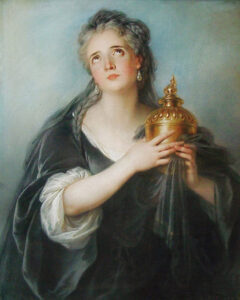
Adrienne Lecouvreur (1692-1730) is one of the most famous French actresses of the time. She mostly played tragic roles, queens, and princesses.
She came from a family of artisans, her father being a hat maker who moved the family to Paris in order to improve the business. Adrienne didn’t have a happy childhood: her mother died when she was still a child, and her father found solace in taverns and inns, leaving her and her sister mostly alone. That’s when she secretly joined a young clandestine theatre troupe. Where she immediately showed her potential and was hired by a touring company and made her stage debut at 14 in Lille. She had several love affairs, had a child from an officer, and was engaged to be married to a baron who, unfortunately, died before their wedding. She eventually found a partner in the son of the city of Strasbourg’s magistrate, the Count François de Klingklin, and they were engaged to be married. Yet, she got pregnant again, and the count’s father managed to convince his son to call off the engagement to avoid the scandal.
In 1717, Adrienne left Strasbourg humiliated and in debt and moved back to Paris, where she was immediately invited to work with Comédie Française. Between 1717 and 1718, she performed 138 times, a record for a beginner.
Her greatest strength as an actor was her ability to portray characters more naturally, distancing herself from the overly stylized form of acting that had been a staple for decades. She also cared much about her wardrobe and makeup, relying on simpler, less ornate gowns. In the Paris years, she had a romantic relationship with Maurice de Saxe, an officer and a famous military commander.
She died at the age of 37, under suspicious circumstances. Rumor had it that she had been poisoned by her rival in love, the Duchess of Bouillon, but no one has been able to confirm it.
Adrienne Lecouvreur’s adventurous life has prompted many retellings of her story, including a 1849 play by Ernest Legouvé and Eugène Scribe and a 1902 opera by Francesco Cilea.
Theatrical Spaces and Costumes
French theatres didn’t change much during the XVIII century in terms of innovations and design. Most “big” changes are, unfortunately, attributed to tragic events, such as fires burning venues to the ground. For example, the Opéra troupe had their theatre destroyed twice: the first time in 1763, when the Palais Royal burned down, and then again in 1781, when their new venue in the revised Salle Des Machines also succumbed to fire. The company eventually moved to a new theatre, the Porte-Saint-Martin, and stayed there until the end of the century.
The Comédie Française never moved from its converted tennis court until the end of the century, only changing a few minor things, most notably abolishing the presence of the audience on the stage and creating a more defined distinction between the stage and the house. In 1782, the company moved to a new theatre (the present-day Odéon), which was bigger and much better equipped. The theatre also only allowed the audience to be seated, thus eliminating the standing area in front of the stage (the pit).
Scenery greatly benefited from removing the audience from the stage, as it allowed for greater spectacle and more scenic effects to be implemented as the audience sight lines were now covered by masking and by some distance. Yet, most of the innovations in scenic design that were implemented in France actually came from Italy, such as, for example, the previously described “scena ad angolo” invented by Bibiena.
Costume design and practices also didn’t change much from the previous century. Costumes either came from the actor’s personal wardrobe or the company’s stock. Famous actors would invest as much as they could in costumes, and often there was bitter rivalry about who had the best costumes.
A slight change in this direction happened with Adrienne Lecouvreur, one of the most well-known actresses of the time. As she became an advocate for a more realistic style of acting, she also applied that concept to her costumes, so for tragic roles she would wear a simple, classic-looking tunic, while for comedies she retained more fashionable attire, although much tamer than what the audience was used to seeing.
Germany
For most of the 17th Century and all throughout the 18th Century, theatre in Germany struggled to find and assert a national identity for a variety of reasons, some of which included language differences and political divisions. Most of the “established” theatre came from abroad –from Italy, France, and England– and was mostly for the benefit of the upper classes, who had access to education. More popular forms of theatre, targeting less learned audiences, tended to still reflect Medieval practices and subjects or were presented by the church (mostly by the Jesuits) for educational purposes.
So towards the end of the 18th Century, German scholars, writers and philosophers, along with the Italians and the French ones, grew restless about this kind of indoctrination and about the Neoclassical principles and the previous century’s interpretations of Aristotle’s principles. Yet, the Germans veered towards a more emotional and somewhat irrational approach to life, which would translate into their artistic activity in all fields, theatre included. The biggest cultural movement pushing forward this neo-romantic agenda about individualism, freedom of speech, and of religion was called Storm and Stress (Sturm und Drang) and included people like Friedrich Schiller and Wolfgang Goethe. The movement was named after the title of a play by Friedrich Maximilian Klinger, who was also part of the group.
Storm and Stress advocated for a stronger emphasis on emotions, as they were considered the driving factor in human behavior. This would entail exploring and developing more intense dramatic structures and themes, as well as using more compelling and passionate language.
Individualism was also promoted, as it celebrated the uniqueness of each human being (in particular the rebels). Finally, artists felt a stronger attraction and connection to nature with all of its majestic power, and this deeply influenced all works of art.

An interesting feature of German theatre of this time is the rise of a more structured approach to theatrical activities, in particular with the work of Johann Wolfgang von Goethe (1749-1832). Goethe wrote all sorts of fiction and nonfiction, including the seminal novel The Sorrows of Young Werther, which many scholars consider the manifesto of German early Romanticism. As a playwright, he wrote several plays about classic myths and, notably, Faust (Parts 1 and 2), which is probably the most famous one to this day.
What sets Goethe apart from other playwrights and theatre artists of the time is his ongoing collaboration with fellow artist and playwright Friedrich Schiller at the Weimar theatre, which Goethe directed.
Many believe that Goethe’s approach to staging Schiller’s plays paved the way for what would become standard practice for directors. In particular, his rigorous approach to rehearsals and to the actors’ need to be on time, know their lines, and work as an ensemble rather than as isolated units changed the German theatrical scenario of the time.
During his tenure as the director/manager of the Weimar theatre, Goethe wrote “Rules for Actors”, a manual featuring more than 50 rules that actors needed to follow.
The Baroque Theater and the Castle complex in Český Krumlov (Czech Republic).
Český Krumlov is a small resort town in the Czech Republic, a couple of hours south of Prague and close to the Austrian border. The town and its monuments have been included in the UNESCO World Heritage Site. The most interesting sights include the Castle Complex and the Revolving Theatre.
The complex of the Castle included one of the only two fully operational baroque theatres in the world.
The Baroque theatre in Český Krumlov was built between 1680 and 1682 under the reign of Prince Johann Christian von Eggenberg. Prince Adam Zu Schwarzenberg renovated it in 1765, adding the new and modernized stage machinery to accommodate seamless scene changes and more special effects, and giving it a more Rococo vibe thanks to the design of Italian architect Andrea Altomonte.
During the 20th Century, the theatre was only used a few times, in 1902 and between 1958 and 1966 when it closed to the public. The preservation and renovation process took over thirty years, and in 1992, the theatre went under the management of the Foundation of the Baroque Theater in Český Krumlov. Scrupulous work from many experts over the years has allowed the theatre to regain all of its beauty and functionality, and it opened to the public again in 1997. While renovations are still ongoing, the theatre can operate tours and occasional productions of Baroque operas.
The Castle features another very interesting detail: a frescoed ballroom with some of the best preserved scenes of Commedia dell’Arte characters and masks.
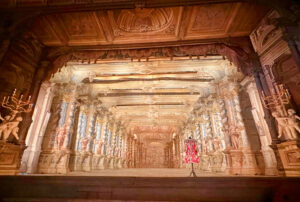

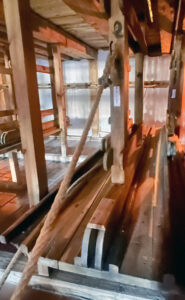
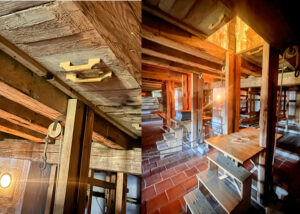
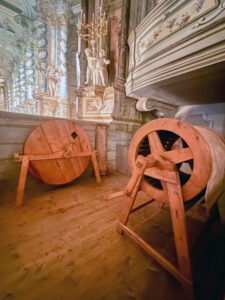
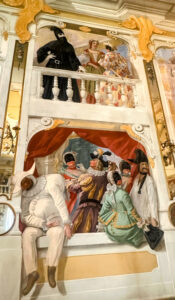
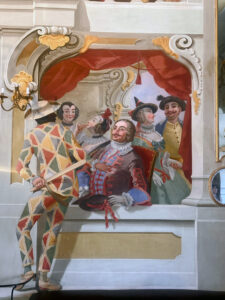
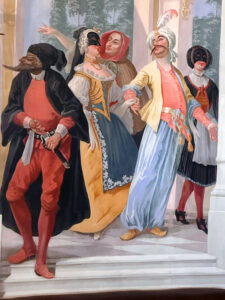
TAKEAWAYS
Paris was still the cultural center of France, despite the socio-political and economic turmoil the country was facing.
Opera comique became very popular, as it was introduced in Paris by the Italian theatre troupe. The Italian style comedic opera clashed with the French opera comique.
The three “official” theatre companies operating legally in Paris were the Opéra, the Comédie Française, and the Italian Company.
There were several smaller and private theatre companies that operated illegally, which were called Boulevard theatres. While the legal companies struggled financially, boulevard theatres were quite successful.
The most important writers of the time were Voltaire and Diderot, who were both involved in writing and editing the Encyclopédie.
Other important writers are: Dancourt, Regnard, La Chaussée, Marivaux, and Beaumarchais.
One of the most influential actresses of the time was Adrienne Lecouvreur.
In terms of theatrical design and architecture, France followed most innovations that were introduced by the Italians. Some new theatres opened as a result of old theatres burning down.
The greatest innovation was taking the audience off the stage and fully separating the performance space – the stage – from the auditorium. The standing space in front of the stage (the pit) was also abolished, so that the audience would only be seated.
Vocabulary
Giovanni Battista Pergolesi
Intermezzi
La Serva Padrona – The Maid Turned Mistress
Vittorio Alfieri
Alessandro Scarlatti
Carlo Goldoni
The Mistress of the Inn
Servants of Two Masters
The Boors
The Two Venetian Twins
Piero Chiari
Carlo Gozzi
L’Amore delle Tre Melarance – The Love for the Three Oranges
Turandot
Ferdinando Bibiena
Angle Perspective – scena ad angolo
Filippo Juvarra
Pompei and Ercolano
Giovanni Battista Piranesi
Comédie Française
Opéra
Boulevard Theatres
Querelle des Bouffons
LaGrange-Chancel
Prosper Jolyot Crébillon
Voltaire
Denis Diderot
Florent-Carton Dancourt
Pierre Carlet de Chamblin de Marivaux
Pierre Claude Nivelle de LaChaussée
Alain René Le Sage
Encyclopédie
Adrienne Lecouvreur
Bureau de Législation Dramatique
Exercises
Students should be researching the evolution of theatre in the 18th Century in other countries (including the U.S.A.).
The instructor should divide the class into groups, with up to 5 group members, and assign a country to each group.
Each group should then investigate the country they had been assigned and prepare a short 10-minute presentation on it.
The presentation should follow the format of the chapter of this book; therefore, it should include: a historical overview, the major playwrights (with their work), the evolution of theatrical spaces, the scenic design, costumes, and a brief investigation of the actors and theatre companies.
Each group should present its research to the class.
| Time Period | Event | Significance |
| 1701–1714 | War of the Spanish Succession | Weakened France economically; rising middle-class taxation created social pressure that fueled Enlightenment and revolutionary ideals. |
| Early 1700s | Opera dominates Italian stages. | Straight plays and tragedies decline. Commedia dell’Arte becomes repetitive. Most playwrights write librettos instead of original plays. |
| 1716 | Comédie Italienne was established in Paris. | Italian troupe led by Luigi Riccoboni brings Commedia dell’Arte back to Paris, broadening theatrical diversity. |
| 1724 | Merope by Scipione Maffei was printed. | One of the only notable early 18thCentury Italian tragedies, rooted in classical themes. |
| 1725–1750 | Opera Buffa rises in southern Italy | Comedic operas in dialect became popular with common audiences; spread to Milan and Venice. |
| 1733 | Goldoni’s first play, Amalasunta | A tragedy staged in Milan marks the beginning of Goldoni’s prolific career. |
| 1746 | Goldoni writes The Servant of Two Masters | Blends scripted comedy with Commedia elements; signals move toward realism and away from improvisation. |
| 1752 | La Serva Padrona causes Querelle des Bouffons | Pergolesi’s opera provokes public debate in Paris over Italian versus French musical theatre aesthetics. |
| 1753 | Goldoni moves to Paris | Leaves Venice to join Comédie Italienne due to artistic rivalry and financial instability. |
| 1758 | Diderot’s Discourse on Dramatic Poetry | Advocates of the drama bourgeois—middle-class drama with realistic characters and moral situations. |
| 1760 | Goldoni writes The Boors | Written in Venetian dialect, satirizes conservative patriarchy and reflects growing middle-class voices. |
| 1761 | Gozzi writes The Love of Three Oranges | Launches a return to fairy-tale Commedia, opposing Goldoni’s realism; gains popularity in Italy, Austria, and Germany. |
| 1763 | The Palais Royal burns down | The home of the Paris Opéra is destroyed by fire; theaters begin relocating and rebuilding. |
| 1767 | Hamburg National Theatre was founded | German theater reform mirrors Enlightenment ideals from France and Italy; national identity in the arts emerges. |
| 1771–1772 | Diderot’s domestic dramas staged | The Natural Son and The Father of a Family promote realism and elevate the lives of ordinary people on stage. |
| 1777 | Beaumarchais founded the playwrights’ union | Bureau de Législation Dramatique defends authors’ rights, leading to early copyright legislation. |
| 1782 | Comédie Française moves to the Odéon | New theater architecture enforces physical separation between actors and audience; improves staging possibilities. |
| 1784 | The Marriage of Figaro premieres | Beaumarchais’s revolutionary comedy critiques aristocratic privilege, long suppressed before its debut. |
| 1789 | The French Revolution begins | Theaters are nationalized; censorship intensifies, but revolutionary and class-conscious themes gain prominence. |
| 1791 | The first copyright law was passed in France | Ensures playwrights receive payment and creative control, a milestone for author rights in theater. |
| 1793 | Goldoni dies in Paris | He left behind over 150 comedies; his reforms shaped modern European comedy. |
| 1830 | Diderot’s Paradox of Acting was published (he wrote it in 1773) | Posthumous essay sparks debates over acting theory: emotional truth vs. technical precision. |
